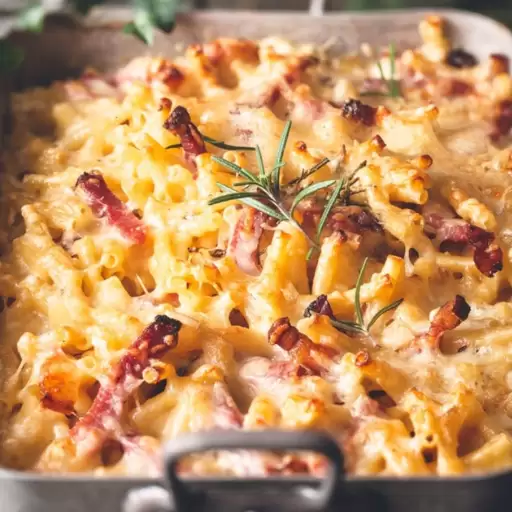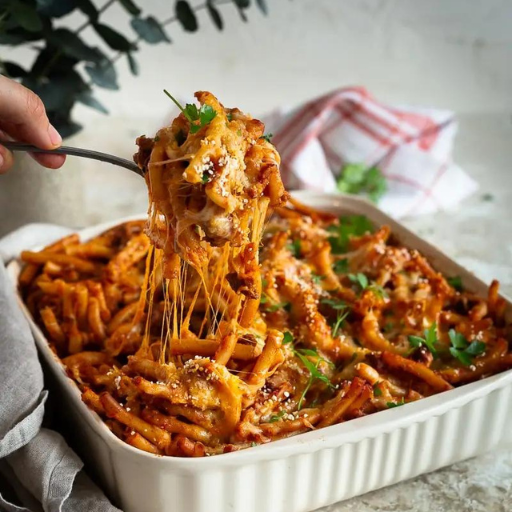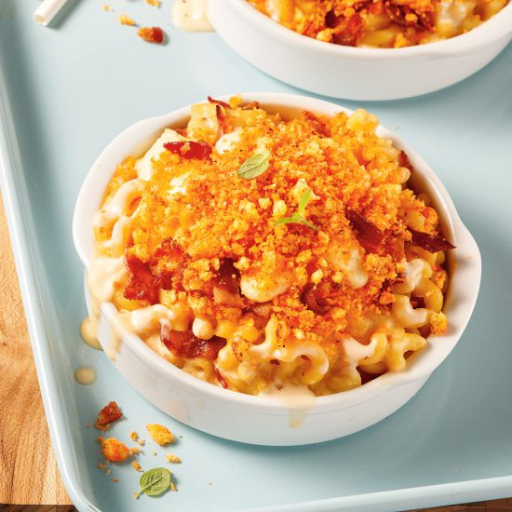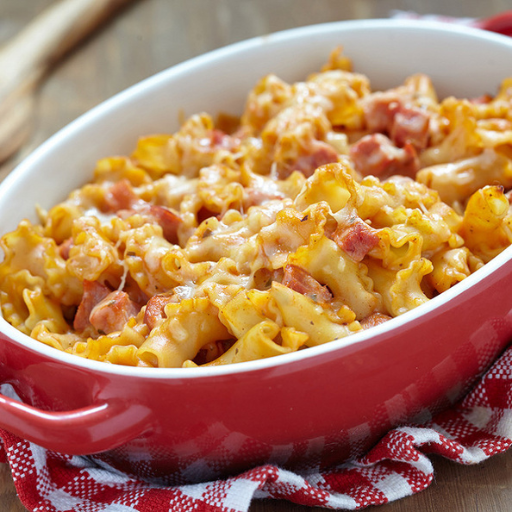Welcome to our culinary journey where we explore unique and delectable dishes from around the world. In this blog, we delve into the rich and savory world of Macaroni au Gratin, a traditional Haitian dish that combines the comforting textures of macaroni with the irresistible allure of melted cheese. Whether you’re a seasoned home cook or a culinary novice, this article will guide you through the history, ingredients, and preparation techniques that make Macaroni au Gratin a beloved staple in Haitian households. Get ready to tantalize your taste buds and bring a bit of Haitian warmth to your dinner table.
What is Macaroni au Gratin?
How Macaroni au Gratin works: an understanding of the basics
Macaroni au Gratin is a classic Haitian comfort food that combines elbow macaroni with a rich cheese béchamel sauce which is often spiced up and flavoured with local seasonings. It is then baked until its top turns golden brown and crispy to give it a nice contrast between its creamy inside and crunchy exterior. The dish’s beauty lies in its simplicity and use of great quality ingredients such as sharp cheddar cheese, fresh herbs among others. This makes Macaroni au Gratin so perfect for a main meal or heavy accompaniment; it defines what Haitian home cooking is about; comfort and joy on one’s plate.
The Beginnings of Macaroni Gratin
The origins of Macaroni Gratin date back to Europe, particularly France where “gratin” refers to a cooking method that forms a crusty, brown surface. This technique became popular in the 1700s and was adopted by various cultures around the globe. In Haiti, the French influence can be seen in dishes like Macaroni au Gratin which have elements of both local tastes and ingredients together with classical French techniques. Over time, Haitian cooks have added their unique touch to the dish, incorporating native spices and seasonings that reflect the country’s rich culinary heritage. With these two cultures blending their flavor profiles together, there emerged this dearly loved dish in the culinary world of Haiti.
Why Macaroni au Gratin is an All-Time Comfort Food Favorite
Macaroni au Gratin remains one of favorite comfort foods because of its velvety richness as well as comforting warmth served at the family table. Combining elbow macaroni with cheese béchamel gives such a dish deep satisfaction and nostalgia feelings. The béchamel sauce is an important element in any traditional French cuisine and it consists simply out f butter-flour roux, milk and cheese producing a very silky texture. It serves as the base for a tangy flavor, thanks to sharp cheddar cheese which provides depth to this entire taste. The creamy inside is complete with a crispy golden crust at the top when baked.
Technical Parameters:
- Cheese Selection: In order not to be overpowered by béchamel sauce, it is better to choose strong flavored sharp cheddar. With other cheeses such as Gruyère or Parmesan added, however, complexity can be achieved.
- Béchamel Sauce: Achieve by using the right amount of flour, butter and milk (which is often 1:1:10).
- Baking Temperature and Time: Cook at 350°F (175°C) for about 20-30 minutes until brown on the top surface and bubbling from the sides.
- Spices and Seasonings: Moreover, nutmegs are common additives while salt; pepper also specific Haitian spices like thyme and Scotch bonnet pepper are used to spice up these dishes with a difference in taste.
Together all these factors make this dish one of those comfort foods that have become so well loved among people who want food that is not only tasty but reminds them of their own culinary traditions.
How to Make Macaroni au Gratin?
A list of ingredients for the Recipe Macaroni au Gratin
- Elbow Macaroni: 8 ounces (225 grams)
- BUTTER: 4 tablespoons (1/2 stick)
- All-Purpose Flour: about 30 grams
- Milk: a liter
- Sharp Cheddar Cheese: 200 grams, grated
- Gruyère Cheese (optional): 100 grams, grated
- Parmesan Cheese (optional): 50 grams, grated
- Nutmeg: a quarter teaspoonful
- Salt and pepper to taste,
- Thyme dried is one teaspoonful or one tablespoonful of fresh.
- Scotch Bonnet Pepper’s one finely chopped (optional for heat).
- Topping- Breadcrumbs(100gms-1cup)
Technical Parameters Explanation:
Cheese Selection:The use of sharp cheddar cheese will guarantee a robust flavor that is well matched with béchamel sauce. Inclusion of Gruyère and Parmesan cheese may bring out other flavors and complexities.
Béchamel Sauce:A suggested ratio of flour, butter and milk by weight, is 1 :1 :10 results in thick pourable consistency important to the creamy texture of the meal.
Baking Temperature and Time:At 175c° (350°F) for around 20-30 minutes the top part should become crispy brown whilst still remaining creamy inside with bubbles at the edges showing that it has cooked through fully.
Spices and Seasonings:For example nutmeg provides some warmth, salt & pepper boost up all round tastes while thyme & Scotch bonnet peppers add special spice notes bringing out regional delicacies.
Step-by-Step Guide to Making Macaroni and Cheese
Preheat the Oven: Turn on your oven to 350°F (175°C) so that it can be properly heated before you put the mac and cheese in.
Cook the Macaroni: In a big pot, boil salted water. Put macaroni weighing 1 pound (450 grams) or according to the package instructions until al dente. Drain and set aside.
Make the Béchamel Sauce:
- Melt 4 tablespoons of butter in a medium saucepan over medium heat. Remove from heat, whisk in all-purpose flour about 4 tablespoons until smooth with no lumps of flour left cook for about one minute to avoid raw taste of flour.
- While still whisking constantly add milk gradually by whisking steadily avoiding formation of lumps in the béchamel sauce; continue cooking until thickened and simmering.
Add the Cheese: Stir into barley cooled béchamel sauce about 2 cups or 200gms grated sharp cheddar cheese slowly till melted and smooth. When ready, mix in 1 cup or100gm Gruyère as well as half a cup or50gm Parmesan if you like them melting completely.
Combine the Macaroni and Cheese Sauce: Mix cooked macaroni properly coated with cheese sauce ensuring that every piece is evenly covered.
Prepare for Baking: Place your mixture of macaroni and cheese into greased baking dish. This will make it crunchy on top.
Bake: Put this baking dish inside preheated oven then bake it at about twenty minutes thirty minutes plus up to when bubbling around edges but golden brown and crisp on top.
Serve: Allow the macaroni and cheese to cool for a few minutes before serving. This is great with your favorite side dishes – it’s creamy, cheesy, and packed with flavor!
Pro Hints for a Truly Baked Gratin
- Get the Right Potatoes: Go for floury potatoes like Russets or Yukon Golds. The high percentage of starch gives them a creamy interior without getting mushy.
- Make Uniform Cuts: For uniform and thin slices, use mandoline slicer. It ensures that the dish cooks evenly and has an even texture throughout.
- The Secret to Layering: Layer your potatoes uniformly with slight over lapping of each slice to form structure. Flavor is enhanced by adding small amounts of cheese and seasoning between layers.
- Use Good Spices: Each layer should be seasoned properly with salt, pepper, as well as other spices such as thyme or rosemary so that one enjoys every bite.
- Infused Cream: Simmer garlic, thyme or bay leaves in the cream before pouring it over the potatoes. This adds up rich flavor to your gratin
- Bake Slowly: Bake the gratin at a low temperature (approximately 325°F or 165°C) for longer duration to ensure that potatoes cook thoroughly inside out thus achieving a soft and velvety texture.
- Golden Topper; Finally broil the top of your gratin for few minutes until you achieve crispy golden brown crust on top. Ensure close supervision so that it does not burn.
- Leave Some Time Before Serving: Leave it alone for ten to fifteen minutes after baking. This will allow settling down hence easier portioning when serving neat portions.
What Variations Exist for Macaroni Gratin?
Classic Cheese Combos to Discover
- Parmesan and Gruyère are a delightful combination: The taste of Parmesan is sharp and salty, contrasting well with the nutty flavor from Gruyère. This mixture makes a sophisticatedly pleasing gratin.
- Cheddar and Mozzarella: Mix in some sharp Cheddar with stretchy Mozzarella for a gooey, melty experience. Enjoy the above ingredients as they guarantee an awesome creamy texture that stretches when served comfort food.
- Gouda And Fontina: A smooth and luscious gratin is achieved by combining Fontina’s buttery creaminess with Gouda’s mild sweetness. In this blend, you will find both strong and mild flavors which appeal to kids and adults alike.
Incorporating Haitian Twists into your Gratin Recipe
- Plantains: Include ripe or green plantain slices in your gratin for a unique Haitian twist. Plantains add subtle sweetness and starchy texture that enhances the creaminess in each layer of your dish.
- Epice (Haitian Seasoning): Use generous amounts of Haitian “epice” which consists of garlic, bell peppers, parsley and other herbs to spice up the dish. This provides rich aromatic depths that are particular to Haiti.
- Pikliz: Apart from cheese, serve your gratin alongside Haitian pikliz – spicy pickled vegetable relish. It has tangy spices that contrast nicely with creamy cheesy gratin thereby enhancing over all experience.
These elements not only bring out delicious flavours typical for Haitian cuisine but also introduce new tastes along with smells into ordinary gratins so it becomes tasteful dish you can easily remember.
Exploring Different Pasta Types: Rigatoni… And More!
When exploring different pasta types, each one has its own unique properties and best uses to consider.
- Rigatoni: With their large ridged cylinders rigatoni works well with chunky sauces as the grooves hold every flavor. Baking like casseroles or gratins is particularly great for it.
- Penne: This tubular pasta, which can be smooth (lisce) or ridged (rigate), is highly versatile. Penne pomodoro and penne all’arrabbiata are classic dishes that highlight this pasta’s ability to complement tomato-based sauces.
- Farfalle: Commonly known as “bow-tie” pasta, farfalle suits best when served with light creamy sauces or in pasta salad. It is fun shape and a visually pleasing addition to any meal.
- Orecchiette: With a name meaning “small ears”, this pasta works well with chunky vegetable sauces or sautéed greens and garlic. Every bite will taste delicious since its concave surface will capture some sauce or veggie.
- Linguine: Linguine alle vongole, for instance, is made of seafood and thicker than spaghetti but not as heavy as fettuccine; while aglio e olio is prepared using fish oil. It stands up well in these specific dishes hence linguine also makes excellent seafood meals.
- Fusilli: The spiral shape of fusilli makes it easier to trap meats and vegetables making them ideal for heavier types of salads too. For example those consisting meat bases.
These pastas provide distinct experiences each time they are used therefore creating diverse and satisfying meals requires an understanding of their unique characteristics.
Common Problems and Solutions in Making Macaroni Gratins
What makes My Cheese Sauce Runny?
A number of factors can result in a cheese sauce that is too thin. One usual problem is an excessively high proportion of liquid to cheese; the sauce will not be thickened properly if there is more milk or cream than cheese in the mixture. Moreover, a lack of proper thickening agents such as flour might cause the final product not to reach its desired consistency. Furthermore, overheating the cheese breaks it down and causes it to become runny; hence, melting it over low heat is very important. Lastly, pre-grated cheese that contains anti-caking agents may make the sauce fail to thicken correctly so it should be grated just before use.
Tips for avoiding Overcooking Macaroni
The mushy texture resulting from overcooking macaroni does not go well with macaroni gratins. Here are some tips on how to avoid this problem:
- Follow Cooking Time on Package: It is always advisable to comply with the recommended cooking time stated in pasta package. In most cases, a majority of pasta products take 7-10 minutes for them to achieve al dente stage.
- Check for Al Dente: Al dente implies that pasta has been cooked until it remains a little bit firm when bitten into. Take out some grains and check their doneness two or three minutes earlier than they are supposed to cook before draining.
- Use Plenty of Water: Use at least 4-6 quarts per pound of pasta in boiling water for uniform cooking process and prevent sticking together.
- Stir Occasionally: Stirring macaroni occasionally during its preparation prevents it from lumping together.
- Salt the Water: Adding around 1-2 tablespoons salt per gallon enhances flavor and ensures right cooking.
- Shock with Cold Water: For future baking purposes, one should boil macaroni for slightly lesser time prior to shocking it using cold water which stops any further cooking hence preventing overcooking as it bakes.
These principles will ensure that your macaroni has the perfect texture every time.
How to Get a Golden Brown Crust?
Achieving a golden brown crust on your macaroni gratin is about good baking techniques and the right ingredients. First of all, make sure that you are cooking the dish at high temperature; usually, around 375-400°F (190-200°C). Therefore, this helps in developing crust while avoiding overcooking inside. Second, sprinkle a mixture of breadcrumbs and grated cheese on top before putting it to bake. The breadcrumbs provide texture and the cheese melts into brown layer which forms an excellent crust. Further, with some butter added to the topping, a deeper color can be achieved when baking by browning it slightly on top. Finally, consider finishing with broiling for some golden touches during the last minutes of baking while watching against burning.
Can Macaroni au Gratin be Made Ahead of Time?
Gratin Preparation in Advance
By all means, you can prepare macaroni au gratin ahead of time, which makes it a great dish for those who are on the go or host parties. Specifically, I cook macaroni and make cheese sauce as always, then mix them up and pour into a baking tray. I add breadcrumb and grated cheese topping but do not bake at this point. Instead, I cover the dish with plastic wrap or foil paper, put it in my refrigerator and keep it for up to 24 hours. Whenever I want to serve, I only bake it within the recommended temperature in oven that was preheated before; usually adding extra minute since it is cold. This technique ensures that when your meal is served hot inside with golden crusts decorated along the edges.
Macaroni au Gratin Reheating Techniques
In regards to macaroni au gratin reheating there are several techniques that I have learned about. First of all set your oven at 350°F (175°C). Place aluminum foil on top of your casserole dish to keep moisture in thus preventing over-browning on top. Put the gratin into the oven and allow it to warm through for about 20-25 minutes. If you wish to regain crispiness remove cover for last five minutes of heating period. For smaller quantities microwave may be faster—make sure though that such dish is microwave-safe and covered with wet paper towel so that food doesn’t dry out while microwaving it at medium power for one minute intervals stirring gently between until heated throughout.
Ways to Store Macaroni au Gratin Freshness
Here are some storage tips that can help you maintain the freshness of macaroni au gratin. Afterwards, let the dish cool completely by placing it at room temperature without leaving it unattended after two hours otherwise growth of bacteria could begin occurring. Upon cooling down, I place the macaroni au gratin in airtight containers. This part is important because it holds on to moisture and prevents odors from other foods in the fridge from getting into the dish.
For short-term storage, I keep the dish in the refrigerator at or below 40°F (4°C). It stays fresh for up to three to four days. I also opt for freezing occasionally hence dividing it into freezer-safe dishes or wrapping with heavy-duty aluminum foil. If well preserved, it can stay frozen at 0°F (-18°C) up to three months. On days I need to have this meal once again, I defrost it by putting it inside my fridge overnight then heat.
Moreover, whenever I store such meals, I mark them so that I do not go beyond the recommended date of consumption for quality purpose.
Reference sources
-
Savory Thoughts: Haitian Macaroni au Gratin
- Savory Thoughts offers a detailed recipe for Haitian Macaroni au Gratin, including essential ingredients such as rigatoni, bell peppers, and cheese. The source provides clear instructions and practical tips, making it a credible guide for those interested in creating an authentic Haitian dish.
- Read More 1
-
Haitian Recipes: Macaroni au Gratin
-
Haiti Open: Macaroni au Gratin Recipe
Frequently Asked Questions (FAQs)
Q: What are the main elements of Macaroni au Gratin?
The main ingredients in macaroni au gratin include macaroni, various cheeses such as gruyere cheese or grana padano cheese, heavy cream, kosher salt and breadcrumbs.
Q: How do you cook the macaroni for this Haitian recipe?
However, after boiling until it is al dente, you can drain it in a colander to remove excess water before combining with the cheese and cream sauce.
Q: What type of cheese is best for Macaroni au Gratin?
It is better advised to use several varieties to get good taste. People often suggest Gruyere and grana padano. There are also some jarlsberg or creamier cheeses that can make your dish delicious.
Q: How do you make the cream sauce for Macaroni au Gratin?
Make golden brown glazed cheese by stirring in cup-fulls of shredded cheese into seasoned heavy cream which has been brought up to boiling point.
Q: Can you make Macaroni au Gratin in a cast iron skillet?
Macaroni and Cheese can be prepared using a skillet made out of cast iron. This technique will help guarantee that the gratin dish cooks evenly and melts the cheese perfectly.
Q: How long should you broil the Macaroni au Gratin?
You should broil it till its crust turns golden brown due to caramelization of its topping. Usually it takes around 5-7 minutes but keep an eye on it so as not to burn your food.


















